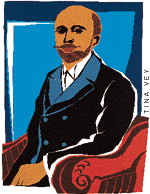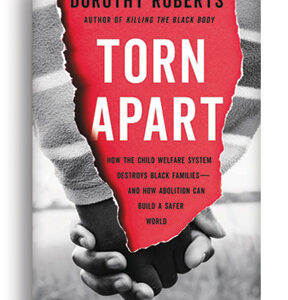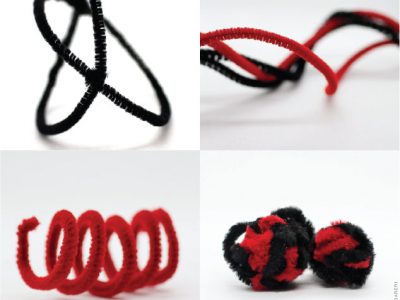Homage to DuBois: Revisiting the Problem of the Color Line

IN an 1898 article titled “The Study of the Negro Problem,” W.E.B. DuBois observed that what he intended to study was “not one problem, but rather a plexus of social problems, some new, some old, some simple, some complex. And these problems have their one bound of unity in the fact that they group themselves about those Africans whom two centuries of slave-trading brought to this land.”
DuBois was an assistant instructor in Penn’s Department of Sociology when he wrote those words, published in The Annals of the American Academy of Political and Social Science. That article served as a proposal for his landmark work The Philadelphia Negro: A Social Study, which was published in 1899 by the University of Pennsylvania Press.
While neither his position at Penn nor his “pitiful stipend” (to use Dubois’ own words) were commensurate with his qualifications (which included a Ph.D. from Harvard), the University made some belated amends this past February, sponsoring a two-day conference — “The Study of African American Problems” — in his honor. Fittingly, the papers presented at it will be published in the Summer 2000 issue of the Annals.
“We are extraordinarily proud” of the fact that it was at Penn that DuBois “carried out his extraordinary research for The Philadelphia Negro,” said Dr. Judith Rodin CW’66, president of the University, who acknowledged that the treatment he received at Penn “was wrong, and he deserved far better.” Today, she said, “we must strive to sustain his legacy, to tend to the fruits of his scholarly labors.”
Dr. Tukufu Zuberi, associate professor of sociology and one of the main organizers of the event — along with Dr. Elijah Anderson, the Clarence and William Day Professor of Sociology — noted that as the 20th century draws to a close, “DuBois’ blueprint is as vital, as relevant and as inspirational as it was at the start.”
DuBois’ sociology, he added, “is historical, it is statistical, it is demographic, it is biological and it is cultural. So it really requires a very clear and crisp focus from a lot of varying and diverse areas and disciplines.” As a result, the conference, which drew DuBois scholars and aficionados from around the country, covered a wide range of disciplines and topics. Geographically, they ranged from Philadelphia’s seventh ward (DuBois’ area of study for The Philadelphia Negro) to Ghana (where he lived out the last years of his life). And the subject matter ranged from analyses of gender and political economy to culture and anthropology and statistical investigation.
Anderson’s paper revisited the typology of The Philadelphia Negro, noting that DuBois had broken down the local black community into four classes: the talented and well-to-do, whose mostly light-skinned members constituted a middle-class “colortocracy” in the pigment-driven racism of the day; the “hardworking, decent laborers who were getting by fairly well” and tended to be somewhat darker complected; the “worthy poor” who were working or trying to work but barely making ends meet; and the “submerged tenth,” many of whom were engaged in criminal behavior and who “were in effect beneath the surface of socioeconomic viability.”
Today, Anderson argued, six basic groups can be discerned within Philadelphia’s black community: The black elite, who have “both high visibility and money” and understand “the mores and values of the white community and share them to some extent”; the middle class and the lower-middle class, both of whom have benefited from affirmative-action programs and the support of “wise” whites and blacks, but who are “often mistaken for members of the black lower class,” an association they strongly resist and resent, even as they sometimes feel guilty about their own success; the “solid” working class, which is shrinking as well-paying manufacturing jobs disappear; the “working poor,” who are on the “lower fringes of the working class”; and the “very poor or underclass,” who lack the “skills and wherewithal to compete in the current system” and who correspond roughly to the “submerged tenth” of DuBois’ day.
Furthermore, a shift in the “stratification pattern” has led to a different kind of internal division among blacks, which Anderson described as “Type A” and “Type B.” The Type As, he noted, “focus on characteristics of ascription (such as skin color),” and are “resigned to the notion that whites are unalterably prejudiced toward blacks and are beyond help,” while the more cosmopolitan Type Bs “balance such traits with those of achievement (such as education and experience).” Some Type A blacks, he said, “are Type A in large part because they have seen nothing else,” and because the “social isolation they experience as a result of the segregated, caste-like system of race relations held over from Jim Crow makes them feel that the wider system is unreceptive to them.”
Dr. Fatimah L.C. Jackson, professor of anthropology at the University of Maryland, was only half joking when she spoke of “an insurance policy” for African Americans. She was referring to the richly varied genetic database found among people of African ancestry — one that is just beginning to draw the appreciation of some in the scientific community. “Humanity,” she explained, “spent more time in Africa than anyplace else in the world.”
Despite that fact, Western science has long reflected a bias toward “privileged whiteness” and the “universalization of European and European-American norms,” noted Jackson, whose paper discussed the anthropological “mismeasurement” of African Americans. Historically, she said, African Americans have been most valued by anthropologists, epidemiologists, sociologists and psychologists as a homogenous counterfoil “against which European Americans might find solace, reaffirm their centrality in the human story, reiterate their geographical expansiveness and restate their dominance and unity.”
That pattern continues to some extent today, although a growing number of researchers are heeding the important clues about humanity’s origins — and the potential contributions to modern gene therapy — offered by the study of African and African-American biodiversity. Far from being appreciated in the past, she said, the visible differences between members of the human species “have been given profound, usually wrong and often devastating interpretations.”
Indeed, the concept of race itself has been misapplied throughout history, noted Dr. James E. Bowman, professor emeritus of pathology and medicine and senior scholar of the MacLean Center for Clinical Medical Ethics at the University of Chicago, whose paper was delivered by Dr. Robert F. Murray Jr., professor of pediatrics and medicine and chairman of the Department of Genetics and Human Genetics at Howard University. “Bob Murray and I have stated that there are as many racial classifications as there are investigators,” Bowman wrote. “Today we know that even though genetic variation is used to delineate populations and ethnic groups, often there is more intragroup variance than intergroup variance.” After all, noted Bowman, Africa is the home of both the tallest people in the world — the Tutsis and Nuer — and the shortest people in the world — pygmies.
Though he decried such holdovers from slavery as the “one-drop rule” — the notion that a person born in the United States with any African ancestry is an African American — Bowman stopped short of calling for the complete eradication of racial categories, saying, “We must know who we are.”
Physical anthropology, according to Jackson, has long tried to organize race into neat boxes: “the prototype black, the prototype Asian, the prototype European … ” In this respect, African Americans were “problematic,” Jackson said, because of their “undetailed lineage” and uneven “mixing” with other races. To carefully consider those factors, however, would have required scientists to take an uncomfortable look at the circumstances of actual individuals’ lives, as well as the painful legacy of American slavery.
But look they must, Jackson said. “We now know though that African genetic diversity may hold the key to understanding all human origins and that the bulk of human biological (including genetic) variability is found among African peoples.” Alluding to DuBois’ famous comment in The Souls of Black Folk that the “problem of the 20th century is the problem of the color line,” Jackson suggested that that problem is now being “reformulated,” explaining: “The problem is not who, what and where is the Negro, for the Negro is in everyone and thus is everywhere.” Ironically, now that evidence points to Africa as the birthplace of the modern human, she noted, researchers are “looking to find which Africans are the progenitors of non-Africans in general and Europeans in particular.”
After describing a technique known as “ethnogenetic layering” that is being used by her colleagues at the University of Maryland to evaluate human variation within and across ethnic groups and geographic areas, Jackson said: “We’re trying to develop techniques to make sure that the biodiversity [of African Americans] is appreciated” and that the resources made available in the “post-genome era” will be of benefit to them.
Bowman, however, held out less hope for human understanding. “One hundred years from now, we will have conquered most, if not all, diseases, genetic and otherwise, including, perhaps, even death … Nevertheless, I also predict that although these advances may come to fruition … our inhumanity to each other and to peoples who are different from ourselves will not be conquered.”
Dr. Mary Frances Berry, the Geraldine R. Segal Professor of History who serves as head of the U.S. Commission on Civil Rights, noted that DuBois’ work and participation in white mainstream organizations “helped to bring about some change,” and that after 1906, fewer articles in the Annals “invoked heredity and more cited social and economic causes for key indicators of problems among African Americans.”
DuBois’ findings in Philadelphia, she noted, made him realize that he had to be “not just a social scientist but an activist” as well.
“If we have any interest in being like DuBois, instead of just writing and talking about DuBois,” said Berry, “we must understand that following his example means much more than being a public intellectual who writes for mainstream publications and graces an occasional meeting or dinner at the White House. It means a commitment to act for social change, to rub shoulders with activists on a regular basis and to relish even being attacked as too radical. It also means understanding that DuBois was not just a complicated man, possessing an inquiring, analytical mind, who became an activist. He tediously taught himself to articulate his ideas and goals to the public with passion, felicity and grace. He believed that there is a public debate that must be engaged. He thought it too important for scholars to remain onlookers, if they shared his vision of helping to ‘raise’ not just themselves but the race.”
DuBois, she added, “was always a Big Thinker who asked ‘Big Questions,'” even though the “ethnocentric lists of Big Thinkers usually ignore him. His Big Question was ‘What shall be the place of the Negro in the new industrial order?’ asked in 1935. Our Big Question today should be ‘What shall be the place of black Americans in the new technological order?'”
One small part of that new technological order was demonstrated by Dr. Henry Louis Gates Jr., chairman of the Afro-American Studies department at Harvard University. After giving a lively account of the long, tortuous history of the Encyclopedia Africana — which DuBois first conceived in 1909 but was never able to get off the ground because of funding problems — Gates unveiled the recently-released CD-ROM Encarta Africana, a multimedia encyclopedia co-edited by himself and Dr. Kwame Anthony Appiah, chairman of Harvard’s Committee on African Studies. A print version of the encyclopedia will be published in November. The project goes back to 1973, Gates recalled, when, as a graduate student at the University of Cambridge, he and a professor and an undergraduate “made a pact that we would try to edit a truly pan-African encyclopedia like DuBois wanted to do in 1909.”




